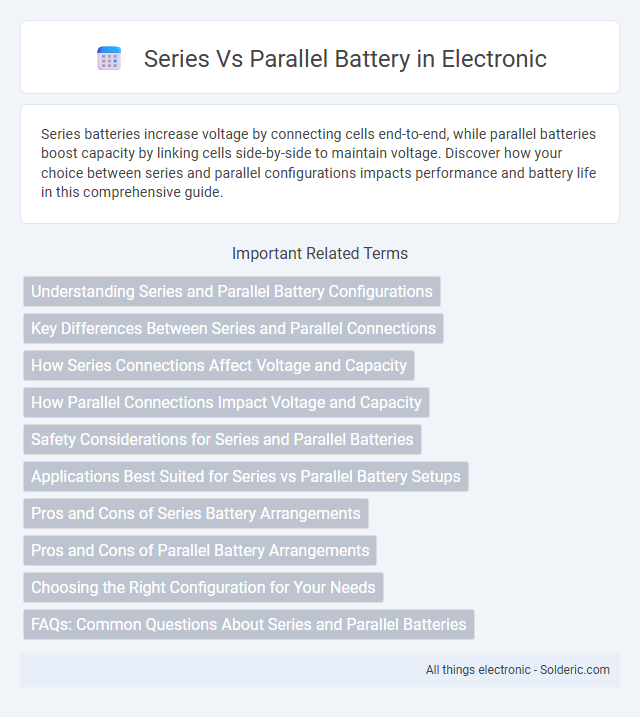Series batteries increase voltage by connecting cells end-to-end, while parallel batteries boost capacity by linking cells side-by-side to maintain voltage. Discover how your choice between series and parallel configurations impacts performance and battery life in this comprehensive guide.
Comparison Table
| Aspect | Series Battery Connection | Parallel Battery Connection |
|---|---|---|
| Voltage | Sum of all battery voltages (increased voltage) | Equal to the voltage of a single battery |
| Current Capacity (Ampere-Hours) | Same as a single battery | Sum of all battery capacities (increased capacity) |
| Application | Used to increase system voltage | Used to increase current capacity or battery life |
| Risk | Failure of one battery affects whole system | Failure of one battery has less impact |
| Internal Resistance | Increases total resistance | Decreases total resistance |
| Charging | Requires higher voltage charger | Voltage same as single battery, higher current charger needed |
Understanding Series and Parallel Battery Configurations
Series and parallel battery configurations impact voltage and capacity differently; series connections increase voltage by summing the individual cell voltages while maintaining the same capacity, whereas parallel connections keep the voltage constant and increase overall capacity by summing the ampere-hours. Understanding these configurations helps you design power systems optimized for specific energy and power requirements. Properly selecting series or parallel arrangements ensures efficient battery performance and longevity in applications ranging from electronics to electric vehicles.
Key Differences Between Series and Parallel Connections
Series battery connections increase voltage by linking cells end-to-end, combining their individual voltages while maintaining the same current capacity. Parallel battery connections boost overall current capacity by connecting all positive terminals together and all negative terminals together, keeping voltage constant across the battery bank. Key differences include voltage summation in series versus current summation in parallel, and impact on battery life and performance depending on load requirements.
How Series Connections Affect Voltage and Capacity
Series battery connections increase the total voltage by summing the voltage of each individual cell while maintaining the same capacity (ampere-hours) as a single cell. This configuration is ideal for applications requiring higher voltage output without changing battery life duration. The overall capacity remains constant because current flows through each cell sequentially, limiting the total ampere-hour rating to that of the weakest cell in the series.
How Parallel Connections Impact Voltage and Capacity
Parallel battery connections maintain the voltage of a single cell while increasing the overall capacity and current supply by combining multiple cells' ampere-hours. This configuration enables longer battery life and higher energy availability without changing the system voltage, making it ideal for devices requiring extended runtimes. Parallel wiring distributes the load evenly across cells, reducing strain and enhancing battery performance and longevity.
Safety Considerations for Series and Parallel Batteries
Safety considerations for series and parallel batteries differ significantly due to their configurations. Series batteries increase voltage, raising the risk of electric shock and requiring careful insulation and protection against overvoltage, while parallel batteries maintain voltage but increase current capacity, which can lead to overheating and requires proper thermal management and current balancing. Ensuring your battery system has adequate fuses, circuit breakers, and battery management systems (BMS) is crucial to prevent short circuits, overcharging, and potential fire hazards in both setups.
Applications Best Suited for Series vs Parallel Battery Setups
Series battery setups are best suited for applications requiring higher voltage, such as electric vehicles and power tools, where voltage must match the device's specifications. Parallel battery configurations excel in situations demanding extended battery life and higher current capacity, like solar power storage systems and backup power supplies. Your choice between series and parallel setups depends on whether increased voltage or longer runtime is the priority for your specific application.
Pros and Cons of Series Battery Arrangements
Series battery arrangements increase total voltage by connecting cells end-to-end, making them ideal for devices requiring higher voltage output such as electric vehicles and power tools. However, a major downside is that if one cell fails or depletes, it can compromise the entire battery pack's performance and longevity due to imbalanced charging and discharging. Managing heat dissipation and ensuring uniform cell quality are critical challenges in series configurations to maintain safety and efficiency.
Pros and Cons of Parallel Battery Arrangements
Parallel battery arrangements increase overall capacity and provide longer runtime by combining the ampere-hour (Ah) ratings of individual cells while maintaining the voltage of a single cell. This configuration enhances reliability since a failure in one cell does not completely disrupt the circuit, making it suitable for applications requiring consistent voltage and extended usage. However, parallel batteries may face challenges such as uneven charge and discharge rates, potential current imbalances, and the complexity of ensuring proper battery management to avoid reduced lifespan or damage.
Choosing the Right Configuration for Your Needs
Choosing the right battery configuration depends on your power and voltage requirements. Series connections increase voltage by summing individual cell voltages, ideal for devices needing higher voltage, while parallel connections increase capacity and current by summing individual cell capacities, suitable for longer runtime demands. Understanding your device's voltage and current needs helps you optimize performance and ensure safety in your battery setup.
FAQs: Common Questions About Series and Parallel Batteries
Series batteries increase voltage by connecting cells end-to-end, while parallel batteries enhance capacity and current by linking cells side-by-side. Your choice depends on power requirements: series for higher voltage applications, parallel for longer runtime and greater current. Frequent questions include how to balance charge, the impact on battery life, and safety precautions when mixing battery types or capacities.
Series vs Parallel battery Infographic

 solderic.com
solderic.com